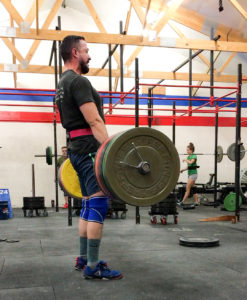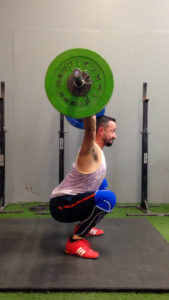
Art joined SEAKR in February 2017 after moving back to Colorado from Dallas, Texas.
Art Alva joined the SEAKR team in February of 2017 as a Systems Engineer. After a short stint in Texas, Art was happy to be back in Colorado – one of the most active states in America. While Art is currently a Cross Fit coach and Olympic lifter, his journey started over 14 years ago, lifting at a local gym with friends.
“I didn’t grow up athletic at all. I was actually a musician,” Art said with a laugh. “I started lifting with friends about 14 years ago. Then ten years ago, I started attending group CrossFit classes. I enjoyed the challenge and became a coach in 2008. Eventually, I also found Olympic lifting and I have been a CrossFit coach and Olympic lifter ever since.”
For those of us who do not hit the gym as often as we probably should, Olympic lifting is comprised of two drills: the “clean jerk” and the “snatch.” Art ensured that the exercises are “intuitive” as he broke down the movements step-by-step.
“Clean and jerk: you pretty much lift the weight off of the ground and onto your shoulders, next you stand up, and then you get it overhead – that’s the jerk. On the snatch: you have a wider grip and you actually lift the weight completely overhead, land in a squat with arms locked out, and just stand up with it. These are very technical movements and it takes a lot of years to master them.”
Art’s biggest piece of advice: don’t skip leg day.

Art demonstrating a dead lift.
“When you are first starting out I would advise doing power lifting. This means squatting, dead lifting, bench pressing, pressing overhead, and so on. These big lifts build up strength and get you ready for Olympic lifting. I think a squat is super important to teach people. It is the running joke that nobody does leg day. It’s those exercises on your quads and hamstrings – the biggest muscle groups in your body – that if you ignore, it is doing a big disservice to your body. Squatting, for example, also takes a lot of core strength. One thing I haven’t done in years is sit-ups. You don’t need to if you are doing those full body exercises like squatting and pressing overhead.”
Art attributed his success as a lifter and a coach to that fact that he was not athletic as a child.
“I feel like the advantage that I have with not growing up athletic is that I never felt like anything came naturally. Similarly, I find that it is harder to teach someone with an athletic background, mainly because you see people learning how to lift in their teens from coaches that probably weren’t meant to teach lifting instruction. It is a lot harder to re-train people versus training somebody who has never lifted before. I had to start from the ground up, too.”
After obtaining his Olympic lifter certification in 2010, Art was by no means done pushing himself. He found his next challenge teaching and providing others with a strong foundation.

Art demonstrating the “snatch” exercise of Olympic lifting.
“I remember this guy who came into the gym severely overweight. He was my only 6 AM attendee. I put him through a basic workout of all body weight exercises. Towards the end I remember looking at him and thinking, ‘oh man this guy is going to puke,’ but he kept showing up. He now has a six pack, and has dropped all of his blood pressure and cholesterol medications. He also transitioned from Cross Fit into lifting. It was cool to see that change in somebody, and to see somebody gain that passion in something that you feel you gave him the foundation for. It is pretty rewarding. I remember thinking, ‘this guy isn’t going to come back,’ but you just never know how people are going to react – and he kept coming back.”
As a coach and engineer, Art is a highly technical individual. He breaks down each movement into basic steps for his students and encourages everyone to focus on how it feels and not how it looks.
“When people come in, I ask them to show me a body squat. From there I can start breaking down if they have hip mobility issues or ankle mobility issues or core stability issues. I try to break it down to that level first, and then give them a bar. I always encourage people to go explore different avenues. Whether you’re interested in getting more flexible, or you have running goals or strength goals, don’t be afraid to take a class and/or hire a coach. Even in my circuit of coaches, it’s still valuable to get coaching from somebody else. A mirror only tells you so much, and sometimes it hinders you from focusing on what you’re doing internally. You are focusing on what it looks like versus how it feels. Sometimes it is better to have someone look at you from the outside and tell you that you can do this better. It is always great to just have that encouragement.”



